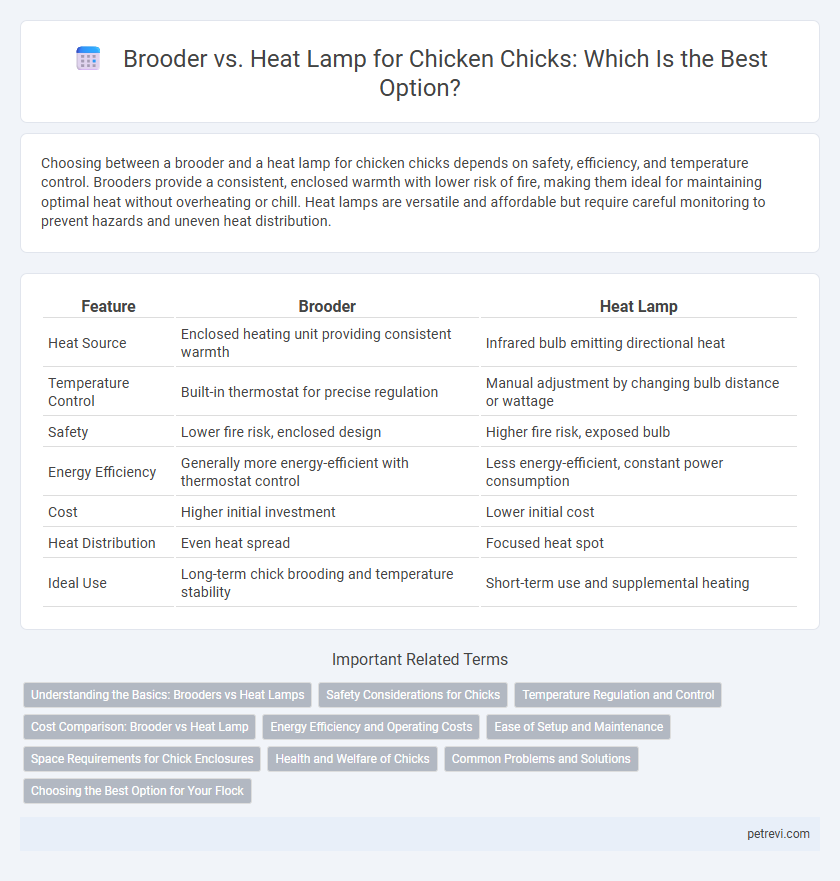Choosing between a brooder and a heat lamp for chicken chicks depends on safety, efficiency, and temperature control. Brooders provide a consistent, enclosed warmth with lower risk of fire, making them ideal for maintaining optimal heat without overheating or chill. Heat lamps are versatile and affordable but require careful monitoring to prevent hazards and uneven heat distribution.
Table of Comparison
| Feature | Brooder | Heat Lamp |
|---|---|---|
| Heat Source | Enclosed heating unit providing consistent warmth | Infrared bulb emitting directional heat |
| Temperature Control | Built-in thermostat for precise regulation | Manual adjustment by changing bulb distance or wattage |
| Safety | Lower fire risk, enclosed design | Higher fire risk, exposed bulb |
| Energy Efficiency | Generally more energy-efficient with thermostat control | Less energy-efficient, constant power consumption |
| Cost | Higher initial investment | Lower initial cost |
| Heat Distribution | Even heat spread | Focused heat spot |
| Ideal Use | Long-term chick brooding and temperature stability | Short-term use and supplemental heating |
Understanding the Basics: Brooders vs Heat Lamps
Brooders provide a controlled, enclosed environment with consistent warmth and humidity tailored to chicken chicks' needs, ensuring optimal growth and health. Heat lamps offer adjustable heat sources but require careful placement to prevent overheating or chilling, posing risks if not monitored closely. Choosing between brooders and heat lamps depends on factors like space, chick number, and desired temperature regulation precision.
Safety Considerations for Chicks
A brooder offers a controlled and secure environment, reducing the risk of fire hazards commonly associated with heat lamps. Heat lamps can cause burns or overheating if not properly monitored, posing dangers to delicate chicken chicks. Ensuring proper ventilation, stable placement, and temperature regulation in either method is critical for chick safety and healthy development.
Temperature Regulation and Control
Brooders provide consistent, controlled temperature ideal for chick development by maintaining a stable environment between 90-95degF during the first week and gradually decreasing as chicks grow. Heat lamps offer adjustable heat levels but require careful monitoring to prevent overheating or chilling, posing a higher risk of temperature fluctuations. Effective temperature regulation with brooders supports optimal chick health and growth, while heat lamps demand vigilant control to ensure chick comfort.
Cost Comparison: Brooder vs Heat Lamp
Brooders typically have a higher upfront cost ranging from $50 to $150, but they offer consistent, energy-efficient heating that lowers electricity expenses over time. Heat lamps are cheaper initially, often priced between $10 and $30, but their higher wattage leads to increased energy consumption and greater long-term costs. Evaluating both options, brooders provide a more economical solution for maintaining optimal temperatures in chicken chick rearing.
Energy Efficiency and Operating Costs
A brooder with insulated walls and a built-in thermostat offers superior energy efficiency compared to a traditional heat lamp, reducing electricity consumption by maintaining consistent warmth. Heat lamps, while initially cheaper, often result in higher operating costs due to frequent bulb replacements and energy waste from uneven heat distribution. Choosing a modern brooder system can lower long-term expenses and ensure optimal temperature control for chicken chicks.
Ease of Setup and Maintenance
Brooders offer a controlled and consistent heat source with adjustable temperature settings, making setup straightforward and maintenance minimal due to their enclosed design that reduces draft exposure. Heat lamps require careful positioning and frequent monitoring to prevent overheating or chilling, increasing the complexity of setup and ongoing adjustments. Brooders generally provide a safer, more efficient environment for chicks with less daily intervention compared to heat lamps.
Space Requirements for Chick Enclosures
Brooders require a compact, insulated space that maintains consistent warmth, usually around 1 square foot per chick for optimal growth. Heat lamps need larger enclosures to provide a temperature gradient, allowing chicks to move closer or farther from the heat source depending on their comfort. Proper space allocation in both setups is crucial to prevent overcrowding and promote healthy development of chicken chicks.
Health and Welfare of Chicks
A brooder provides consistent temperature control and a safe environment, reducing risks of overheating, cold stress, and injuries, which promotes better health and welfare for chicken chicks. Heat lamps, while affordable and accessible, can create uneven heat distribution and pose fire hazards, potentially compromising chick well-being. Ensuring proper temperature regulation and minimizing hazards with a brooder supports optimal growth and reduces stress in young chicks.
Common Problems and Solutions
Brooders provide consistent warmth with less risk of overheating, while heat lamps often cause uneven heat distribution and fire hazards; common problems with heat lamps include bulb breakage and temperature fluctuations. Solutions for heat lamp issues include securing lamps with proper fixtures and using thermometer monitors to maintain stable temperatures. For brooders, routine cleaning and proper ventilation prevent respiratory problems and ensure optimal chick growth.
Choosing the Best Option for Your Flock
When raising chicken chicks, selecting between a brooder and a heat lamp depends on the specific needs of your flock and environment. A brooder provides a consistent, enclosed heat source that ensures optimal warmth and safety, reducing risks associated with overheating or fire hazards commonly linked to heat lamps. For precise temperature control and improved chick survival rates, brooders are often the preferred option among poultry farmers aiming to maintain a healthy, thriving flock.
Brooder vs Heat Lamp for Chicken Chicks Infographic

 petrevi.com
petrevi.com